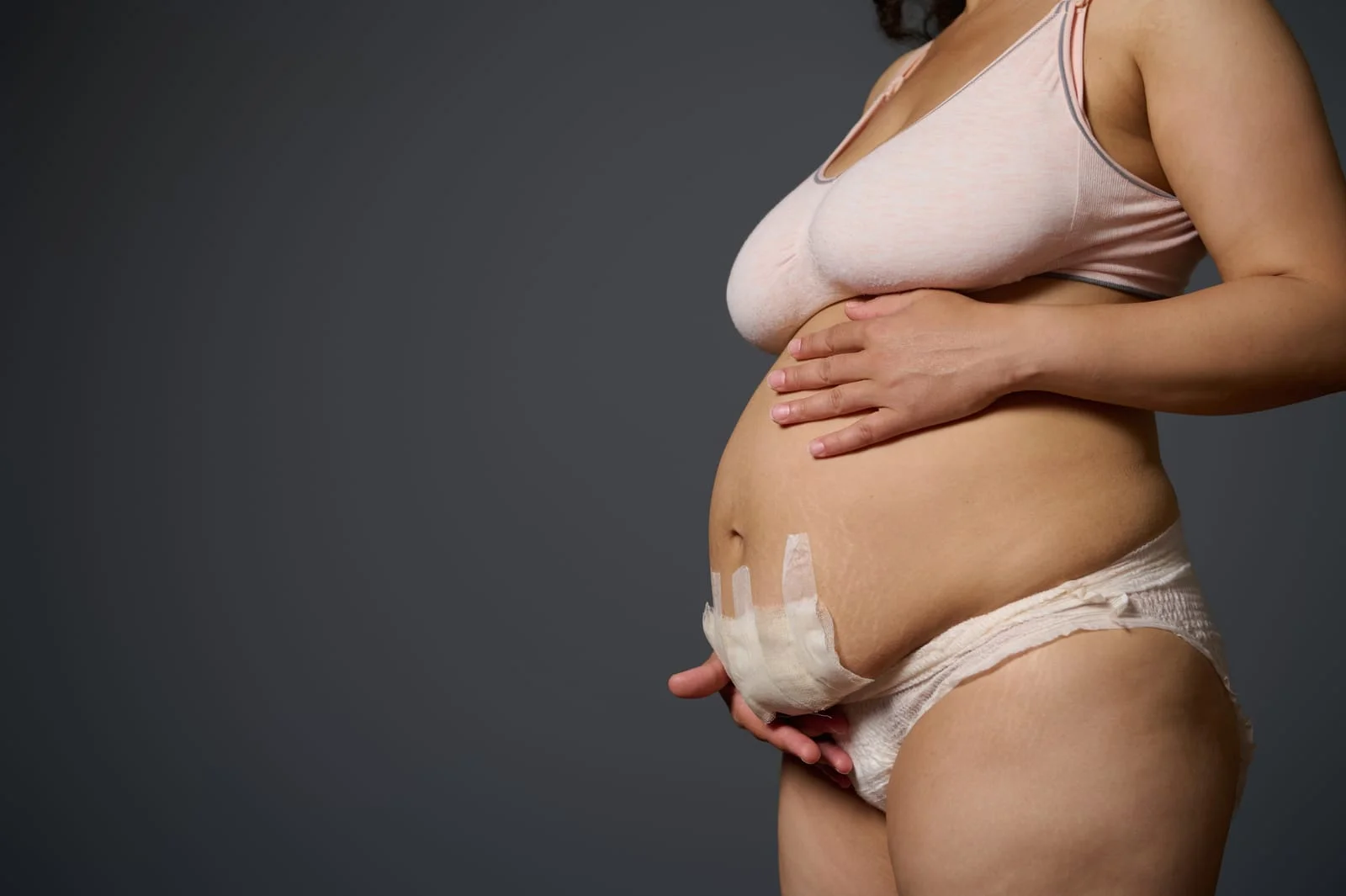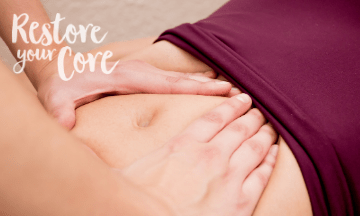
Lauren Ohayon is the creator of Restore Your Core® (RYC®), a comprehensive and sustainable whole-body fitness program that empowers women to achieve ideal pelvic floor / core function and be strong, long, mobile and functional.

It is not uncommon for many postpartum people to experience complications such as pelvic organ prolapse postpartum. Vaginal and rectal prolapse occur when the supporting muscle and tissue structures become weakened during pregnancy and delivery. Despite common belief, prolapse does not only affect women who have had multiple pregnancies or are outside of the advised age, but it can also affect many postpartum people as well. It can be a surprising and shocking experience for many postpartums to discover they have developed a prolapse after vaginal birth. However, in some cases, the symptoms will resolve on their own as their body recovers from delivering their child or can be managed and healed through exercise and proper postpartum aftercare.
In this article I hope to address the ways postpartum people can manage prolapse after childbirth and how you may experience a full recovery.
Get free expert advice and start your postpartum healing journey today
Table of Contents
The truth is, your pelvic floor and uterine wall experience a lot of stress during your pregnancy. In many cases, people will begin experiencing the complications of prolapse and other pregnancy related issues before they deliver their child. A stressful or complicated delivery is not always the culprit for POP or DR. As your child continues to grow within you, the supporting tissues and muscle structures are strained, which can lead to you experiencing complications even before birth. However, it is common for many people to become aware of these issues postpartum. The weakness in the pelvic region can cause some of your pelvic organs (bladder, bowel, uterus) to slip out into the vaginal or rectal walls. Despite many people experiencing resolved symptoms as they continue to heal after their delivery, many may still experience future complications. Some of the most common types of pelvic organ prolapse include:
Uterine prolapse –uterine prolapse involves prolapse of the cervix and uterus down into the vagina
Bladder prolapse (cystocele) -involves a prolapsed bladder into the front wall of the vagina
Bowel prolapse (rectocele) is the prolapse of the vagina into the back wall of the vagina or rectum.
In some cases, these prolapses may coexist. Example: you may experience both a uterine prolapse and bladder prolapse at the same time.
Take 3 steps toward doing the things you love again postpartum
In short, it is not uncommon for people to experience a prolapse after giving birth. As you undergo the many hormonal changes, physical strain and stress, and the weight of your child can weaken the supportive tissues and muscles in your pelvic floor – causing the organs to shift and become misaligned.
Along with the hormonal and physical demands pregnancy can place on your body, a vaginal delivery can also contribute to pelvic prolapse as well. The stretching and straining of the pelvic muscles beyond their limits can significantly compromise the strength and functionality of the pelvic region. Over-stretching can leave scarring and nerve damage resulting in damaged tissues and muscle structures – leading to pelvic organ alignment issues and can cause them to shift downward into the vagina.
There are a host of factors that can contribute to various forms of pelvic organ prolapse. Some of the most common include:
Discover the top 3 steps to regain your fitness and strength postpartum–free
There are many options out there to help you recover from postpartum pelvic organ prolapse. It is important that after your delivery (once you’ve received clearance by your medical professional), to begin a form of postpartum rehab. Offerings can range between physical therapy, physiotherapy, or movement specialists (Restore Your Core®). In many cases, you would treat this condition as you would any other physical injury: REST and light movement. You may also need to treat any other underlying conditions that may be contributing to the prolapse. Some options may include:

Get 3 (free) scientifically-proven steps and regain your postpartum strength and fitness
Practicing safe pelvic floor exercises are important for a sustained recovery and preventing further injury during treatment. Inappropriate exercises or moving too quickly can increase the risk of injury, overloading the pelvic floor, or causing long-term damage to the pelvic floor. Practicing safe pelvic floor engagement and workouts will help strengthen your muscles and the surrounding tissues that have been damaged during your pregnancy and childbirth, helping restore the natural support system for your vital organs.
Safe pelvic floor exercises include those which are low impact and light exercises: walking, stationary cycling, and some yoga poses. More safe exercises can include core strengthening techniques and movements as well are pelvic floor strength training exercises: more intensive yoga poses, stretches, and workouts. Although exercising is important for recovery, it is important that you avoid high impact exercises: intense core exercises, heavy-lifting, or extensive cardio training in order to avoid making the prolapse worse or increasing other postpartum symptoms.
To learn more about safe postpartum exercises, read our additional blog on Postpartum Exercises.
Resting can be one of the most difficult things new moms struggle with remembering to do. As you continue caring for your little one, ensuring you are getting exercise and eating nutritiously, can help you make a better transition back into your daily routine. It is extremely important that you remember to rest throughout your postpartum period. Rest is especially vital to your prolapse recovery. As you reach the end of each day (and periods of down time during the day), rest with your feet elevated to help relieve any symptoms you may be experiencing. Rest can significantly promote your overall prolapse recovery.

Straining during bowel movements and constipation can increase prolapse symptoms. Although I am not a dietician, in many cases, changing your diet and eating high fiber foods can help relieve symptoms of constipation that can reduce the amount of straining you have been experiencing.
For many people, postpartum prolapse can correct itself over the course of your postpartum recovery. Lifestyle changes, exercise, proper diet, and avoiding exercises of movements that may prevent your body from healing are the first steps toward prolapse recovery.
After giving birth, your pelvic floor and core muscles will be in the process of healing for at least a year. Although many people may begin being active again after the first 8-weeks postpartum, often people will continue to face pelvic pain and symptoms of diastasis recti for months after delivering their child. Both your core and your pelvic region have gone through significant changes in order to accommodate your baby. Attempting to quickly get back into an exercise or workout routine can add to your pain and place unnecessary pressure and strain on your core and pelvic floor muscles – especially when they are already weakened.
Every woman is different and the recovery length can change depending on many factors. Healing can take anywhere from a few months to over a year, depending on whether or not there are underlying conditions which may be increasing the pain. While there are no overnight success stories, there are many many success stories of people like you who have healed their pelvic organ prolapse by taking these steps slowly and surely.
Unfortunately there has been little research conducted on whether or not postpartum prolapse will heal overtime. However, we do know that some women will have relief from symptoms within six months while others may experience chronic problems for years if not decades. The severity of prolapse also plays a role – those with milder cases usually recover more quickly than those with a severe prolapse.
We don’t have a direct correlation that says if you have more babies, your pelvic floor will be weaker or stronger. Studies show women who never had any kids also experience prolapse alongside mothers of multiple children with minimal to no symptoms of prolapse. If you have a prolapse and want to have more children, do so without fear.
Prolapse is a condition that occurs when the pelvic organs fall into or out of their normal positions. This may occur after childbirth, but it can happen to anybody – even if you delivered your baby through cesarean section! One in two women will experience prolapse during their lifetime.
Every woman is different and the recovery length can change depending on many factors. Healing ranges from a few months to over a year, depending on whether or not there are underlying conditions which may be increasing the pain. While there are no overnight success stories, there are many successful people like you who have healed their pelvic organ prolapse.
Physical therapy is the least invasive option for treatment of prolapse. During your evaluation, your physical therapist or doctor will assess your posture and pelvic strength as well as perform an internal examination of the pelvic floor muscles, and suggest exercises and best practices to reduce intra-abdominal pressure in the future. You may also learn breathing techniques to perform during bowel movements or while lifting something heavy.
Loose skin after pregnancy is not something that can be fixed overnight. Diet and exercise postpartum are key to reducing the appearance of loose tummy skin, though it will take time for your body’s shape to return back to a healthy, restored state. It is important to understand that a slim body is not the sole sign of strength, health, and restoration.
No matter how you gave birth, never underestimate the need for recovery. Your body has been stretched and stressed to the max during pregnancy, labor, and delivery so it needs a chance rest now! The first six to eight weeks postpartum are considered the standard recovery time. You may have had an easy pregnancy or childbirth but your body is still recovering from all of that stress. There’s no quick fix/solution after giving birth.

“There is no thank you big enough for Lauren Ohayon existing and thinking and helping so many of us. Every time I do something I never thought I’d do again she is part of the reason why.”
Laura Gregg
in this FREE video and get the support you deserve


Postpartum physical therapy can be a great way to restore function and strength in your core and pelvic floor muscles. Giving birth places a strain on your body and it...

The postpartum recovery period typically lasts well beyond common expectations. Guiding and supporting your postpartum patients and clients through this transitional period requires effective strategies tailored to their individual needs....

Postpartum recovery can be difficult for anyone, but there are particular considerations to keep in mind after a C-section. Read on to learn more about how to begin a safe...

Have you just had a baby, or are you about to give birth? Read on for pelvic floor exercises that facilitate faster postpartum recovery, enhance overall well-being, and improve long-term...

Introduction Pregnancy and delivery are a massive undertaking. Your body has to adapt and expand to allow the baby to grow, and having a C-section means you face a whole...

Giving birth takes a toll on your body – both physically and emotionally. Many postpartum people will feel overwhelmed and exhausted after giving birth, which can make it difficult to...

Before you begin any exercise routine, consult with your doctor for medical clearance. Practice patience with yourself and your body, and rest, lots of rest! I recommend waiting at least...

Post-pregnancy pain, whether it be pelvic floor pain or joint pain, is a shared experience among many postpartum people. However, postpartum pain, especially in pelvic pain, can vary in frequency,...

*No spam, just quality content and support
Please check your inbox soon.

Take 3 steps toward doing the things you love again postpartum
© 2025 RYC®. All rights reserved.
in this FREE video and get the support you deserve